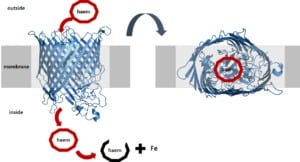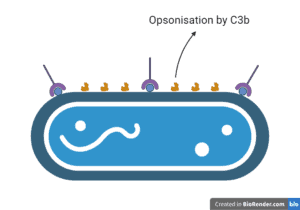Bacteria always try to find new and better places to live. Some of them even make their ways into human bodies. But as soon as bacteria get to the inside, they are welcomed by a strong army of immune cells. These bind bacteria, eat and kill them. Therefore, our immune cells are trained to specifically recognise and bind bacteria.
However, some bacteria found a way to become invisible in front of the immune cell army. They put on an invisibility cloak so that they can sneak into the human body without being seen. This invisibility cloak is a so-called bacterial capsule. And pathogenic bacteria use capsules to trick the immune system to infect our bodies.
Here, we will explore what bacterial capsules are and how bacteria use them to overcome our immune systems.
About bacteria with capsules
Bacteria that produce capsules are generally pathogens. These are bacteria that can infect us, cause disease and make us sick. And bacterial pathogens use capsules for the infection process. Without capsules, pathogenic bacteria would be eaten and killed by our immune cells.
Bacteria with capsules are for example Klebsiella pneumoniae, Mycobacterium tuberculosis, Haemophilus influenzae, pathogenic and uro-pathogenic Escherichia coli, Neisseria meningitidis and Porphyromonas gingivalis.
Many people carry Klebsiella pneumoniae in their gastrointestinal tract or nose without having any symptoms. However, in some people, this bacterium can enter the blood circulation and cause infections like pneumonia, sepsis, urinary tract infections, bacteremia or meningitis.
The pathogen Mycobacterium tuberculosis causes the devastating disease tuberculosis with almost 1.4 million deaths every year. Haemophilus influenzae infections lead to sinusitis and uro-pathogenic Escherichia coli causes urinary tract infection. Another awful pathogen is Neisseria meningitidis. This bacterium infects the membrane around our brain and leads to the disease meningitis. Lastly, Porphyromonas gingivalis is an oral pathogen that infects and destroys the tissue around our teeth. You might know this disease as periodontitis.
This list of pathogenic bacteria might sound a bit frightening. But it is to highlight the one feature they all have in common: These bacteria use their capsules to enter our bodies and cause these diseases.
So, let’s have a look at what this capsule actually is.
What are bacterial capsules
The bacterial capsule is a thick layer of a sugar-water mix that surrounds the bacterial cell.
The capsule layer consists of long chains of sugar molecules that are attached to the bacterial cell surface. These sugar molecules have different lengths, lots of branches and different attachments. The sugar chains absorb water molecules so that a gooey slime develops. Researchers can even see this under the microscope.

Interestingly, different bacteria can produce chemically identical capsules. But the same bacteria can also produce different capsules. In this case, bacteria add little attachments to the outer tip of their sugar branches. Now, this bacterium “looks” completely different from the outside.
Generally, antibodies bind to these sugars, which is why we call these sugars antigens. However, when bacteria change their sugar tips, they also change their antigens. Hence, another antibody is needed to recognise this new antigen – even though it might still be the same sugar. In this case, we call the bacterium with the new sugar antigen a serotype.

For example, researchers found 80 different antigens and thus serotypes in Escherichia coli based on their capsule sugars. And for Streptococcus pneumoniae, they even identified 93 serotypes.
Now, you might ask yourself what is the function of capsules in bacteria?
Bacterial capsules are invisibility cloaks
A bacterial capsule works like an invisibility cloak. As soon as a bacterium enters the dark halls of our human bodies, it puts on the cloak. Now it won’t be seen by the immune guardians. Like this, bacterial pathogens follow the model of “the best defence for a pathogen is a good defence”.
The players of our immune system recognise and bind to specific molecules on the surface of bacteria. This activates the immune system and attracts more phagocytes. These immune cells eat intruding pathogens and destroy them. Like this, our immune army is always ready to fight the bad guys.
However, the bacterial capsule hides these surface molecules that our immune system usually recognises. Like this, our immune players cannot bind these sugar-coated pathogens. This keeps the immune army deactivated. Now, bacteria can escape the immune system, sneak into our bodies and cause infections.

Our immune system can also fight intruding bacteria by producing antimicrobials. Yet, the sugar capsule of some bacteria can absorb these small molecules and make them useless. Hence, the bacterial capsule acts as a protective layer against immune attacks.
Neisseria meningitidis even has a “capsule-switch”. Once activated, it can cover itself with another sugar layer that looks completely different from the outside. The immune players need to learn again to recognise this new layer, which takes time. Hence, with this “hyper-encapsulation”, Neisseria meningitidis can escape the immune system again.
Overcoming bacterial capsules
Because bacterial capsules are at the outer surface of a bacterium, researchers want to use these components as targets for vaccines. However, since bacteria can change their capsular components, these targets are not very reliable. So, researchers are working on developing vaccines that recognise different serotypes.
For example, a vaccine that recognised different antigens of the capsule in Klebsiella pneumoniae was developed and reached clinical trials. However, the high costs of such an efficient vaccine made this project difficult.
Another approach is to better understand how pathogenic bacteria regulate their “capsule-switch”. If we can prevent bacteria from putting on another cloak, we can help our immune system do its job and kill intruding bacteria. Hence, researchers are looking for ways to achieve this.
Bacterial invisibility cloaks – another way for bacteria to survive
You might now think how nasty bacteria are for using such a capsule to escape our immune system and infect us. However, for bacteria, this is another survival mechanism. If they do not put on their invisibility cloak, the immune system will eat and kill them. So, some bacteria developed this mechanism to overcome their foes.
And I think it is a pretty smart way to survive.











4 Responses
It is a very interesting topic.
Where can I find a complete list of bacterias with invisibility cloaks?
Thank you
Hi Tim, thanks for your comment. I am not sure a complete list exists, but please check out the highlighted scientific reviews for more information on these bacteria.
Keep up with the good work, thank u!
Thanks! Glad you’re happy with it :)